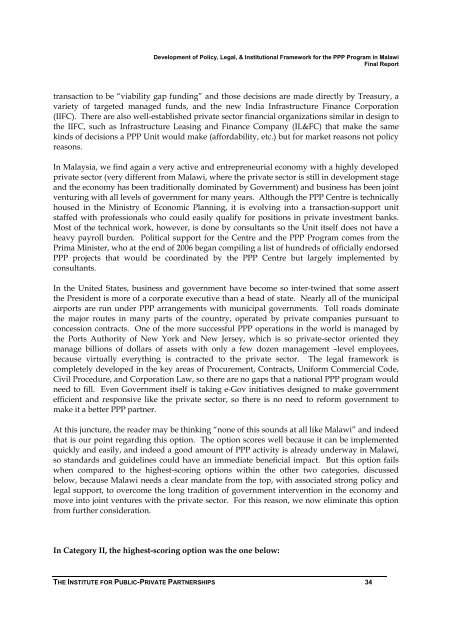Development of Policy, Legal, and Insitutional Framework for - ppiaf
Development of Policy, Legal, and Insitutional Framework for - ppiaf
Development of Policy, Legal, and Insitutional Framework for - ppiaf
Create successful ePaper yourself
Turn your PDF publications into a flip-book with our unique Google optimized e-Paper software.
<strong>Development</strong> <strong>of</strong> <strong>Policy</strong>, <strong>Legal</strong>, & Institutional <strong>Framework</strong> <strong>for</strong> the PPP Program in Malawi<br />
Final Report<br />
transaction to be “viability gap funding” <strong>and</strong> those decisions are made directly by Treasury, a<br />
variety <strong>of</strong> targeted managed funds, <strong>and</strong> the new India Infrastructure Finance Corporation<br />
(IIFC). There are also well-established private sector financial organizations similar in design to<br />
the IIFC, such as Infrastructure Leasing <strong>and</strong> Finance Company (IL&FC) that make the same<br />
kinds <strong>of</strong> decisions a PPP Unit would make (af<strong>for</strong>dability, etc.) but <strong>for</strong> market reasons not policy<br />
reasons.<br />
In Malaysia, we find again a very active <strong>and</strong> entrepreneurial economy with a highly developed<br />
private sector (very different from Malawi, where the private sector is still in development stage<br />
<strong>and</strong> the economy has been traditionally dominated by Government) <strong>and</strong> business has been joint<br />
venturing with all levels <strong>of</strong> government <strong>for</strong> many years. Although the PPP Centre is technically<br />
housed in the Ministry <strong>of</strong> Economic Planning, it is evolving into a transaction-support unit<br />
staffed with pr<strong>of</strong>essionals who could easily qualify <strong>for</strong> positions in private investment banks.<br />
Most <strong>of</strong> the technical work, however, is done by consultants so the Unit itself does not have a<br />
heavy payroll burden. Political support <strong>for</strong> the Centre <strong>and</strong> the PPP Program comes from the<br />
Prima Minister, who at the end <strong>of</strong> 2006 began compiling a list <strong>of</strong> hundreds <strong>of</strong> <strong>of</strong>ficially endorsed<br />
PPP projects that would be coordinated by the PPP Centre but largely implemented by<br />
consultants.<br />
In the United States, business <strong>and</strong> government have become so inter-twined that some assert<br />
the President is more <strong>of</strong> a corporate executive than a head <strong>of</strong> state. Nearly all <strong>of</strong> the municipal<br />
airports are run under PPP arrangements with municipal governments. Toll roads dominate<br />
the major routes in many parts <strong>of</strong> the country, operated by private companies pursuant to<br />
concession contracts. One <strong>of</strong> the more successful PPP operations in the world is managed by<br />
the Ports Authority <strong>of</strong> New York <strong>and</strong> New Jersey, which is so private-sector oriented they<br />
manage billions <strong>of</strong> dollars <strong>of</strong> assets with only a few dozen management –level employees,<br />
because virtually everything is contracted to the private sector. The legal framework is<br />
completely developed in the key areas <strong>of</strong> Procurement, Contracts, Uni<strong>for</strong>m Commercial Code,<br />
Civil Procedure, <strong>and</strong> Corporation Law, so there are no gaps that a national PPP program would<br />
need to fill. Even Government itself is taking e-Gov initiatives designed to make government<br />
efficient <strong>and</strong> responsive like the private sector, so there is no need to re<strong>for</strong>m government to<br />
make it a better PPP partner.<br />
At this juncture, the reader may be thinking “none <strong>of</strong> this sounds at all like Malawi” <strong>and</strong> indeed<br />
that is our point regarding this option. The option scores well because it can be implemented<br />
quickly <strong>and</strong> easily, <strong>and</strong> indeed a good amount <strong>of</strong> PPP activity is already underway in Malawi,<br />
so st<strong>and</strong>ards <strong>and</strong> guidelines could have an immediate beneficial impact. But this option fails<br />
when compared to the highest-scoring options within the other two categories, discussed<br />
below, because Malawi needs a clear m<strong>and</strong>ate from the top, with associated strong policy <strong>and</strong><br />
legal support, to overcome the long tradition <strong>of</strong> government intervention in the economy <strong>and</strong><br />
move into joint ventures with the private sector. For this reason, we now eliminate this option<br />
from further consideration.<br />
In Category II, the highest-scoring option was the one below:<br />
THE INSTITUTE FOR PUBLIC-PRIVATE PARTNERSHIPS 34
















